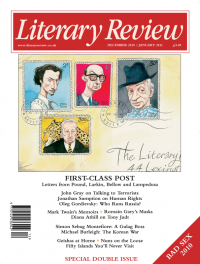Henrietta Garnett
Shades of Grey
The Model Wife: The Passionate Lives of Effie Gray, Ruskin and Millais
By Suzanne Fagence Cooper
Duckworth Overlook 276pp £25
Effie Gray’s story is extraordinary and Cooper feasts upon it with appetite. ‘Her life reads like a novel, full of colour, sensation, despair and romance.’ So does Cooper’s biography. We engage with Effie immediately. Cooper starts her story on the day Effie left her husband, the art critic and social reformer John Ruskin, to return to her parents in Scotland.
Born in Perthshire in 1828, Effie was a charming, witty child. Sent to an excellent boarding school, she became an accomplished pianist and could prattle away in French, German and Italian, dance the polka, and charm the opposite sex. She first met Ruskin when she was twelve. He was twenty-one. Ruskin was suffering from unrequited love and had a prurience for nubile beauty; he became infatuated by the idea of Effie and thought he could mould her to conform to his exacting requirements. He married her in 1848, much to his parents’ dismay.
The marriage was notoriously unconsummated. Nevertheless, it might have endured. Effie was fun and, for most of the time, a model wife. Cooper is excellent at describing not only Effie’s concern with dress – her ribbons and bonnets – but her frustrations too. Effie was socially ambitious and genuinely interested by her husband’s work, but her marriage was sabotaged not so much by a lack of sex as by Ruskin’s parents, who were both uncommonly possessive of their son. The young Ruskins were happiest alone, but Ruskin remained under his mother’s indomitable thumb. Effie didn’t stand a chance. Even so, Cooper is unnecessarily harsh about Ruskin, one of the most complex and intriguing men of his day.
The turning point came in 1853. Ruskin invited Millais to join them on holiday in Scotland to paint the archetypal Pre-Raphaelite portrait of Ruskin in urban dress on a rock beneath a rushing waterfall. Years before, Millais had met Effie at a ball at Ewell Castle. He had asked her to dance and she had declined. Now, Millais and Effie fell in love; and Ruskin behaved in characteristic Machiavellian fashion.
All three became wretched. Ruskin accused Effie of insanity but not infidelity. Effie became hysterical but retained her decorum. Millais was baffled, besotted and angry. Back in London, Effie confided in Lady Eastlake. It’s a pity Cooper doesn’t quote more from the extensive correspondence between Effie and Lady Eastlake – their letters contain wonderful examples of how intelligent Victorian women referred to the taboo subject of marital sex. With Lady Eastlake’s encouragement, Effie grew brave, obtained an annulment (as opposed to a divorce) and subsequently married Millais, by whom she had eight children. She succeeded in her role as Millais’s model wife, running his palatial Kensington house, boosting his image and managing his money. Successful Victorian painters were treated as celebrities, earning enormous incomes and entering high society. Effie was in her element.
Cooper, a distinguished art historian and an authority on Victorians, never bores. If occasionally her enthusiasm for her subject steers her in the direction of the historical novel, what might appear to be the result of a romantic imagination is borne out by very thorough research. Possibly her best chapter is about Effie’s little sister Sophy, who acted as go-between during the nastiest part of Effie’s marriage to Ruskin and eventually went mad. Sophy was only ten when she met Ruskin who, with his predilection for little girls, made much of her. Sophy’s mind was also unhinged by Ruskin’s mother’s insinuations about Effie. Sophy, like Ruskin’s later inamorata Rose La Touche, who was nine when they met, became anorexic and never recovered. Perhaps Cooper could have made more of the parallels between Rose and Sophy. She plausibly suggests that Millais transferred his affection from Effie to Sophy and that this was Sophy’s final undoing. Sophy Gray’s story brings tears to the eyes. Cooper has researched it impeccably and with dignity. I did miss any reference to Millais’s marvellous later landscapes, often painted to the point of physical exhaustion in the driving snows of Scotland. But by then, Effie was nearly blind and this is her story. I cannot recommend Suzanne Fagence Cooper’s biography of Effie Gray more highly to anyone with a heart, a liking for a good read and an interest in things Victorian.

Sign Up to our newsletter
Receive free articles, highlights from the archive, news, details of prizes, and much more.@Lit_Review
Follow Literary Review on Twitter
Twitter Feed
Under its longest-serving editor, Graydon Carter, Vanity Fair was that rare thing – a New York society magazine that published serious journalism.
@PeterPeteryork looks at what Carter got right.
Peter York - Deluxe Editions
Peter York: Deluxe Editions - When the Going Was Good: An Editor’s Adventures During the Last Golden Age of Magazines by Graydon Carter
literaryreview.co.uk
Henry James returned to America in 1904 with three objectives: to see his brother William, to deliver a series of lectures on Balzac, and to gather material for a pair of books about modern America.
Peter Rose follows James out west.
Peter Rose - The Restless Analyst
Peter Rose: The Restless Analyst - Henry James Comes Home: Rediscovering America in the Gilded Age by Peter Brooks...
literaryreview.co.uk
Vladimir Putin served his apprenticeship in the KGB toward the end of the Cold War, a period during which Western societies were infiltrated by so-called 'illegals'.
Piers Brendon examines how the culture of Soviet spycraft shaped his thinking.
Piers Brendon - Tinker, Tailor, Sleeper, Troll
Piers Brendon: Tinker, Tailor, Sleeper, Troll - The Illegals: Russia’s Most Audacious Spies and the Plot to Infiltrate the West by Shaun Walker
literaryreview.co.uk